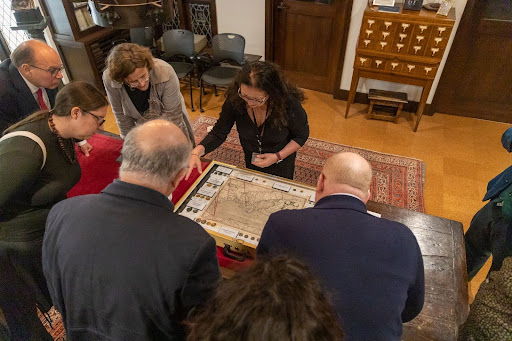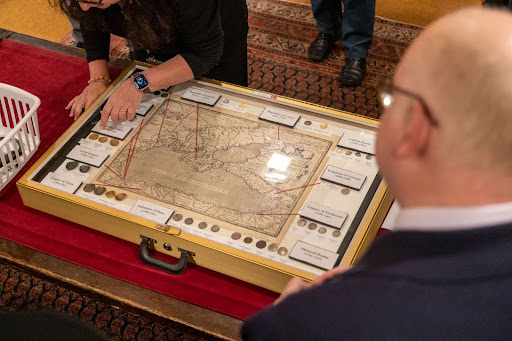Exploring Centuries of History Through Coins: Black Sea Migrations Conference visits PUL
On September 22, 2023, Princeton University Library (PUL) welcomed numismatists, historians, and coin enthusiasts from around the world for a unique and captivating conference— “Black Sea Migrations in the Long Thirteenth Century: Bodies, Things, Ideas.” This conference provided an opportunity for attendees to explore a fascinating exhibition of coins from the 13th century that shed light on the complex history of the Black Sea region.
“The project was founded as a response to a crisis,” explained Teresa Shawcross, Associate Professor of History and Hellenic Studies. “Current geo-political instability in the Black Sea region is resulting in the destruction or dispersal of cultural monuments, museum collections, and other important witnesses to the history of the basin's inhabitants and visitors.”
She added, “While many events have been organized on campus in response to current affairs, we felt that our community needed to be made more aware of the long and complex history of the region -- as well as of the need to safeguard its rich material culture.”
The conference and exhibition came to fruition as a result of Shawcross’ collaborative efforts with Curator of Numismatics Alan Stahl and Byzantine Numismatics Cataloger and Linked-Open-Data Coordinator Elena Baldi.

Elena Baldi shows conference goers a variety of coins in a display in the Scheide Library in PUL Special Collections. Photo credit: Brandon Johnson
"When the planning of the conference started, we were contacted by Professor Shawcross, who asked if we would like to collaborate,” said Baldi. “Professor Stahl thought of a small exhibition to show the coins of our collection that were related to the conference topic, the Black Sea in the long 13th century."
The centerpiece of the visit was the exhibition curated by Baldi, who selected coins that provided a glimpse into the intricate history of the region. "In order to set up the display, I looked at the populations that were settled and interacted, commercially and politically, with each other in the Black Sea area, during the 13th century,” Baldi explained. “There was a lot going on — the collapse of the Byzantine empire, the creation of rump states, the rise of the Latin Empire and its fall less than 60 years later, the Mongol/Arabic populations were settling around the Black Sea at that time, as well as Genoese and Venetians. All of these reigns and empires produced coins."
The exhibition represented the mosaic of cultures and influences that shaped the region during that era. Baldi revealed, "I was able to show at least one example of all the peoples around the Black Sea. I wish our collection was even more complete. For example we only own four small coins of the Golden Horde in particular and these date to the end of the 'long' 13th century, rather than the whole period in which they ruled and settled the northeastern parts of the Black Sea."
Among the standout coins in the exhibition, Baldi pointed out her favorite, a coin with a lion from the Sultanate of Rum.
Beyond their aesthetic and historical value, Baldi believes that the coins have the potential to be used in different educational contexts. "I think coins can be used in different classes since they all tell a story,” Baldi said. “For example, the Latin States never produced coins of the actual ruler, but imitated coins of previous Byzantine emperors. Trebizond produced coins of the same standard as the Sultanate of Rum and the Ilkhanids, while the rump state of Nicea continued with the typologies and denominations of the collapsed Byzantine empire."
The conference also sparked curiosity and opportunities for further research. "Can we identify new typologies for the Latin States? Why does the Sultanate of Rum show animals and people on their coins, even though they are Muslim states? What do mixed hoards found in Crimea tell us?" Baldi asked, noting various avenues for future research.

Elena Baldi showcases the coins in the exhibition, including those from the Republic of Venice, the Golden Horde, and the Kingdom of Georgia. Photo credit: Brandon Johnson.
Shawcross added that all of the coins related to the Medieval Black Sea are in the process of being digitized and made freely available to scholars around the world.
“The result will be an invaluable resource for teachers and researchers not just on this campus, but on other campuses,” Shawcross said. “Many of these coins are known only from a handful of examples and are otherwise inaccessible even to specialists. In cases where we hold multiple examples, the catalog provides information that allows one to make comparisons and see the bigger picture.”
Published on December 4, 2023
Written by Brandon Johnson, Communications Strategist
Media Contact: Barbara Valenza, Director of Library Communications
Newsletter
Subscribe to Princeton University Library’s e-newsletter for the latest updates on teaching and research support, collections, resources, and services.
